
automobiles
.pdf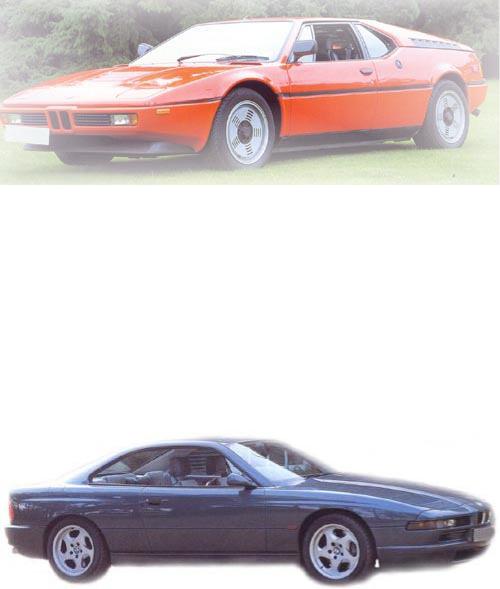
The car was primarily aimed at the Mercedes 300SL market, serious drivers turned to the new BMW.
BMW M1 6-cylinder 3.5 – 277bhp – Top speed 160mph – 0-60 5.6 seconds
Italian styling and German engineered reliability, the M1 was launched in 1979 to take on Porsche’s dominance on the race circuits. However, due to Lamborghini’s financial troubles production was delayed. By the time the car eventually went into production racing rules had changed and the heavy M1 was not suited to the new racing formula. Just 426 M1’s were built.
BMW have a long history of producing fast coupe’s, the latest 850CSi is no exception, a V-12 or V-8, the V-12 (5.6 litre) will get you from Munich to Berlin at 170mph... If you so wish! The M5 has similar performance with a 6-cylinder 3.8 unit.
Not only is the 850CSi extremely quick, the car is luxuriously comfortable. The seats and steering wheel can be adjusted to suit the driver and this information is retained electronically, the steering wheel can also be moved out of position to allow easy access. Manufacturers who can build a high speed car and at the same time superb comfort, are very rare, undoubtedly BMW do the job admirably with the 850.
CLASSIC CAR CITROEN
At the time of the First World War, Andre Citroen had great success in armament production. When the war ended, Citroen, a man
181
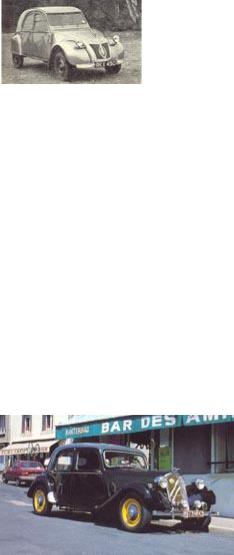
with a great eye for business opportunities, decided automobile production for the masses would be his next venture. He set his company up in 1919, and his first car would be the first mass produced car in Europe. It would also be the first car to have electric lighting and starter. The car (A-Type) soon be-
came very popular.
Citroen, always innovative, introduced the  first network of dealerships and repair garages in Europe. In 1948 the company realised they needed to build a car everybody could afford - the 2CV. The car was the beginning of the legendary “Tin Snail”.
first network of dealerships and repair garages in Europe. In 1948 the company realised they needed to build a car everybody could afford - the 2CV. The car was the beginning of the legendary “Tin Snail”.
In the late 60’s, Citroen acquired a controlling interest in the Italian sportscar builders Maserati. The first car to be produced in this new partnership was the impressive Citroen SM GT. Power came from V-six quad-cam unit, a smaller version of Maserati’s V-eight masterpiece. At 2.7 litres it was just within French tax laws, which came down heavily on engines over 2.8 litres. Sales were in the beginning very good, but it was to be short lived due to the fuel crisis of 1973, at 18mpg it became expensive to run. Production finally ended in 1975.
The first front-wheel drive Citroens came in 1934, the costs of development forced the company into bankruptcy. Michelin came to the rescue. The 11CV went into production in 1935, almost 20 years passed before the line was discontinued.
In 1974 Citroen went under control of Peugeot, but even today the Citroen name lives on with great success.
CLASSIC CAR FERRARI
Enzo Ferrari raced in the 1920’s, in the 30’s he went on to run the Alfa Romeo works team as Scuderia-Ferrari. He became frustrated with Alfa’s decision to concentrate its efforts on road car production and felt Alfa were neglecting their racing heritage, he left the company and began building his own cars...
182
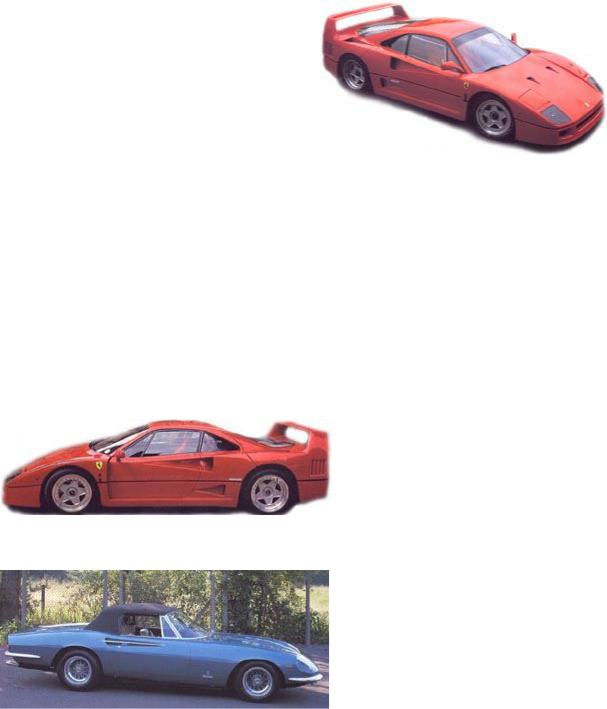
Many, many racing successes followed, but he soon realised road car production was vital to finance his racing ambitions. His first engine was a simple V-12 with a light alloy block and cylinder heads, narrow valve angles, 1500cc with tiny 125cc cylinders, 3 twin-choke webers and twin ignition distributors (remember this is in 1947).
Ferrari hit the world headlines in 1964 with the launch of the 275 GTB, a Ferrari with all new suspension, and a comfortable to drive Ferrari and of course, extremely quick.
In 1968 the Ferrari Daytona
365GTB/4 was launched, the last GT front-engine Ferrari supercar. The car was named in honour of Ferrari’s success in the American 24hour race of the same name, 365 denotes the capacity of each cylinder, four stood for the number of camshafts. This sensational motor car had a top speed of 70mph, in reverse gear that is! Forwards just 175mph.
To celebrate 40 years of production Ferrari built the F40, a road-legal racer, a twin turbo 3-litre 478 bhp 200mph supercar.
Enzo said, if it’s not enough we can fit a wider camshaft and larger turbos.......then you have 678bhp!
|
Sadly Enzo did not |
|
live to see the F50, a similar |
|
car to the F40 but with a 4.7 |
|
litre engine and no turbo’s. |
F40 |
Performance of both the F40 |
|
and F50 was almost identical |
(the F50 slighter quicker acceleration and top speed) The F50 is really an out-and-out racer for the road, not a developed road car. The V-12
Ferrari 365 California
engine is bolted directly to the carbon-fibre chassis. De-
183
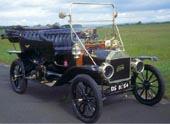
spite more power than the F40, maximum speed will be no greater, ground effect is more important.
The1958 250 GT Spyder California had the body built by Scaglietti although the design came from Pinnin Farina. Just over 100 Spyder’s were built, Ferrari thought this would be an ideal competition road car, but most owners thought this car was just too nice to race! In the early 60’s the California was modified to a short-wheel- base form, many thought it even better looking than the 1958 version. Production ceased in 1963.
CLASSIC CAR FORD
Henry Ford started his working life as an engineer for the Edison Lighting Company Detroit, in 1884. Ford by chance, came across a science journal written by Nicholas Otto, a German engineer who was developing the internal combustion engine. Ford became very interested, some say infatuated, and he decided
to build his own.
He soon got to work, building and developing a car in his spare time in a small shed in his garden. His car, the “Thin Lizzie” was completed in 1896. Ford was now desperate to start his own motor company; by 1899 he had secured enough investors to begin a production run. Initially his first attempts were unsuccessful, he failed to produce a car that could be sold. Eventually however, Ford produced the Model A, sales were good, by 1908 profits soured to over one million dollars. In 1909 Ford decided to concentrate production on the Model T, he wanted to mass produce this car, and build each unit in the shortest time possible, and as inexpensive that could be achieved. By improving his production methods he went on to build each car in just 90 minutes, and at a price of less than four hundred dollars his competitors were left floundering.
His famous “ you can have it in any colour you want, as long as it is black” arose because black paint, was the only colour available in America that was quick drying. By 1926 Ford had sold over fourteen million Model T cars.
184
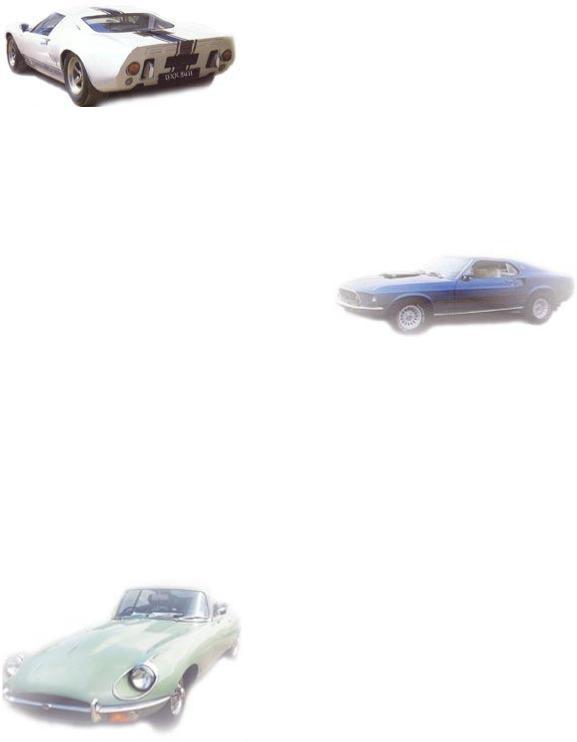
The Ford GT40 was a product of the merged interest of Ford USA and Lola Cars, for one aim - to win the Le Mans 24 hr race. Ford after having their bid for Ferrari turned down, set to work on the GT40. Initially unsuccess-
fully, then Ford handed over control to Carroll Shelby. Eventually, Ford in 1966 gained their greatest ambition and won Le Mans. Ford then went on to dominate the race for the next few years, with four successive victories in total.
The Ford Mustang is one of the great American success stories, a sporty design which appealed to all and caught the spirit of the times perfectly when it was launched in 1964.
The Mustang went on to become one of the fastest selling car of all time, over 400 000 in the first year of production and onemillion units sold by 1966. In all 2.2 million Mustangs would be sold during the production run, 1964-73. A range of options were a great selling point, from a straight 6 to a V-eight - 2790cc to a monster 6997cc giving 395bhp, and 135mph.
CLASSIC CAR JAGUAR
William Lyons and William Walmsley began to get noticed for their flair and imagination in building stylish sidecars. In 1927 the Aus- tin-7 was introduced, Lyons decided to build a more stylish body that could be mounted on the Austin chassis. Henly, who happened to be
one of the major garage owners in the country, immediately placed an order for 500.
185
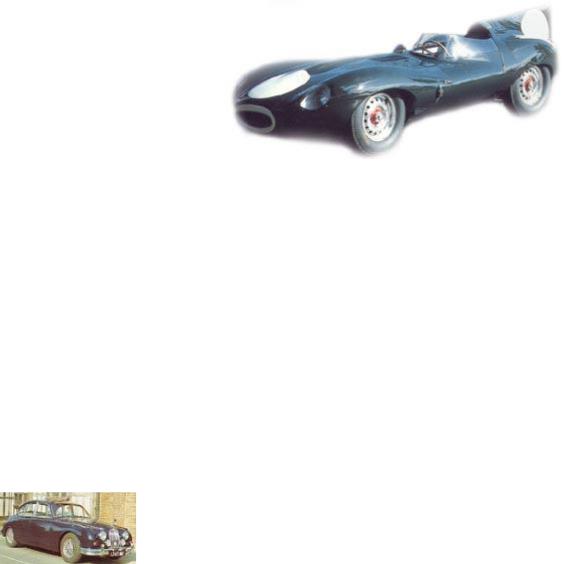
When sales of the cars and sidecars continued to increase the company moved to Coventry, the traditional carmanufacturing centre of England. The Swallow Company had now been in existence 9 years, the
young company was very successful, but Lyons was not impressed, he wanted to expand the company further.
At the London Motor Show of 1931, the SS class was launched, the public were stunned, and especially that such a beautiful car could be bought for considerably less than Ј350. William Walmsley was less enthusiastic and began to lose interest in his partner’s ambitions; he left the company in 1934. In 1935 Lyons was persuaded to change the company name to Jaguar, subsequently SS became the SS Jaguar. Jaguar entered a team of three factory SS Jaguars in the prestigious RAC Rally of 1937, unfortunately, a privateer won the race, in an SS100.
At the 1948 Earls Court Motor Show, Jaguar introduced the fastest motor car to date, the XK 120 Roadster with a top speed of 120 mph, superb  road holding and styling plus a smooth ride.
road holding and styling plus a smooth ride.
In Britain just after the war, it is little wonder this car caused such a sensation; initially it was meant to be a limited volume production car. However the car went on to be a big money earner for Jaguar, most cars were destined for America, the car went on to become one of the greatest classics of all time.
During the 1950’s Jaguar had reached a point in its history of selling only luxury and sports cars. The company also sold a great deal of its cars abroad.
This put Jaguar in a risky position, Jaguar needed to build a car that could be sold at home and to a larger market. To address this, the Jaguar Mk I was launched in 1955. The Jaguar MK II evolved as an instant success in 1959 with a much larger glass area and a redesigned dash. Leather seats were fitted as standard until 1967 when leather
186
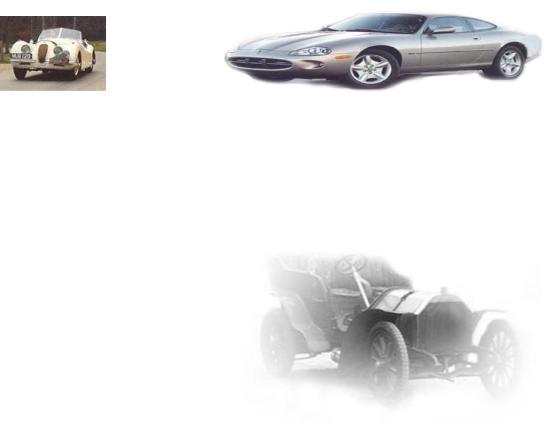
became optional to keep the standard cost down. Another Jaguar classic, its fog / spot lights, also became an optional extra.
The MK II was loved by all, including bank robbers; this was hardly surprising, because this was another record for Jaguar, the fastest saloon in standard production. The 3.8 versions well over 200bhp, and 125mph.
The Jaguar E-Type was an instant classic, launched in 1961. The car was in huge demand from 1961-75, to begin with the company struggled to meet orders. In all, 74000 cars were sold. Some say the best Jag ever made, and the old XK engine now 13 years old, was still used in the early E-Types. The 4.2 Series 1 are generally considered the best.
Sir William Lyons died in 1985.
XK 120
Jaguar XK8
CLASSIC CAR MERCEDES-BENZ
Daimler-Benz was formed in 1883, with Karl Benz, Max Rose and Friedrich Wilhelm Esslinger. The first motor cars were built in 1886. The Benz prototype motor car was first publicly seen in the summer of the same year. At the same time, Daimler was busy
with his first motor car. In 1890, Daimler founded Motoren-Gesellschaft group (DMG) in Stuttgart.
The USA’s first practical internal combustion engine was produced in Connecticut, and was designed with the plans produced by Daimler. In 1924 Daimler and Benz merged companies and became known as “Mercedes-Benz”.
187
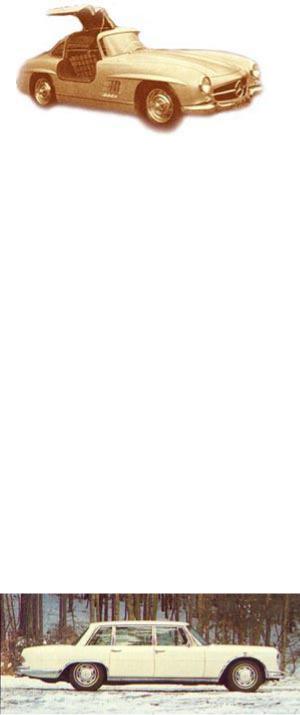
Jellinek the Austro-Hungarian consul in France had the rights to sell Daimler’s cars in Europe and the USA. Mercedes was the name used by Jellinek to sell Daimler’s cars, and was in fact the name of his daughter.
Mercedes quickly moved on to become one of the premier manufactures of motor vehicles in the world.
The Mercedes Benz 300SL of the 1950’s was one of the fastest road cars available. Only Ferrari
and Maserati could get near the performance of this sensational motor car.
The original Gullwing coupe, with its incomparable roofhinged doors, was launched in 1954, however, the Le mans winning prototypes had already been seen in 1952.
The famous “Gullwing” launched in 1954 was not only famous for its doors but also leading the way in fuel injection road cars. The car was roughly twice the price of the Jaguar XK140, so a car only for the very rich. Being rich however, did have its pitfalls, if you were in an accident and the car turned over you couldn’t get out. It was a car with handling problems, a car really for expert drivers only.
In 1962 Mercedes set out to build the ultimate saloon car. Paying little attention to costs, with electric or hydraulic everything. The Mercedes-Benz 600 was launched in 1963. Rolls-Royce had found a match. The car was hugely expensive and was only produced in small numbers; nevertheless it stayed on the Mercedes-Benz production list until 1981.
The Mercedes-Benz 600 was enormous, the standard version was 18 ft ( 5.5 metres ) long. The 6.3 litre V-8 managed to move this car to over 120 mph (190 kph) Between 1963
and 1981 only 2700 Mercedes-Benz 600’s were sold and mainly to heads of state!
188
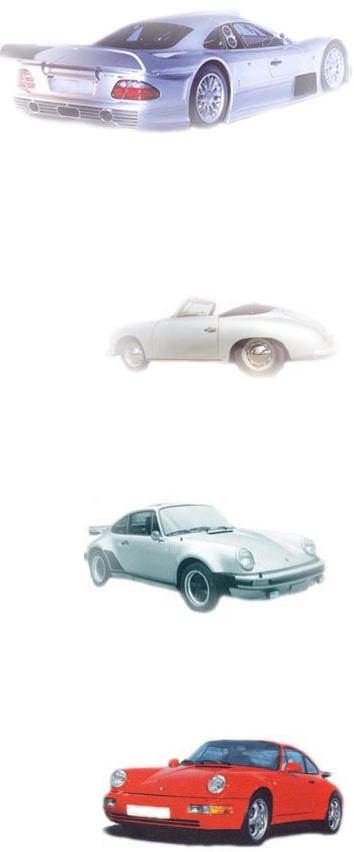
In 1997 MercedesBenz unleashed the CLKGTR - Welcome to the 200 mph club! This car was intended to shed Mercedes’ image, perhaps an unfair description for such a re-
fined marque, but such remarks tend to stick. The car is aimed at the younger generation obviously, but at $750 000 + ? Who can afford one?
CLASSIC CAR PORSCHE
Ferdinand Porsche set up his design consultancy in 1931, but the first car to bear his name would be 15 years later. The 356’s were built in 1946, and went into production in
1948, a close relative of another Porsche design - The VW Beetle. Like the Beetle the 356 was fitted with a flat-four pushrod air-cooled engine, and very similar suspension.
The early cars built in Austria, had split windscreens and 1100cc versions of the flat-four engine, produced just 40bhp. Later there would be a 2-litre model, producing a very respectful 150bhp.
The 356 improved dramatically over it’s sixteen year production run, and became ever more remote from its Beetle roots. These later 356’s were to set the pace for the now famous reputation of Porsche Cars. In 1965 Porsche stopped producing 356’s, much to the disappointment of enthusiasts, however
the Porsche 911 was waiting in the wings.
A cheaper 912 was released which still used the pushrod engine of the 356, but with the 911 bodywork.
189
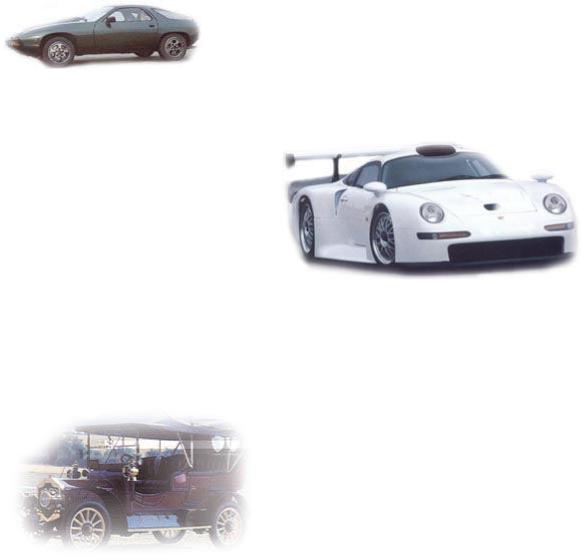
For the launch, Porsche moved production of the 911 to Stuttgart, Germany, in 1964.
Quick and nimble the 911 are one of the most practical of all supercars, and have a superb reputation for reliability. There have been many variations of the 911, but pre-1974 cars are seen as the most classic. Today’s 911 is still going strong and as popular as ever.
There has been a 911 Turbo in the Porsche line-up since the 70’s. Since then the basic design has been considerably revised and improved. Although the 1991 Turbo shares the same basic rearengined set up, it is dissimilar in some respects, most importantly in having a chassis derived from that in the 911 Carrera 2. This makes the 911 Turbo’s power safer to use.
The Porsche 928 front-engined car arrived in 1977, with the new 4-5-litre V8, on option was a Mercedes auto transmission - but then lost it’s sports car listing.
The 928S soon followed, with a 4.7 litre unit, then in 1986 - a fivelitre 170mph supercar.
The road-going GT1 closely resembles the sports racer on which it is founded. Being 911 related, it is powered by a flat-six 3.2 litre turbo engine, although mid - rather than rear positioned. It returns a
weighty 555 bhp - which is only 40 bhp less than the competition car! Top speed 195 mph (312kph).
CLASSIC CAR ROVER
Like many motor car manufacturers Rovers history started in bicycle production. After John Starley, the company’s founder, powered a tricycle in 1901, he quickly moved on to introduce his first four-wheeler in 1904. The company soon built up a
solid reputation for quality. An early Rover feature was the free
190
